HTC EVO 3D vs. Motorola Photon 4G: Choosing the Best Sprint Phone
by Anand Lal Shimpi on August 17, 2011 11:11 PM ESTPerformance
The Photon 4G uses NVIDIA's first mobile SoC with widespread acceptance: the Tegra 2. Although it only started appearing in Android phones and tablets this year, the design itself dates back to a year prior to its introduction. Despite its age, Tegra 2 does very well against the current competition. Its architecture is pretty simple to explain. You get a pair of ARM Cortex A9 cores running at up to 1GHz with a 1MB L2 cache shared between them. Although each core has a pipelined FPU, neither has ARM's MPE - a SIMD engine needed to run NEON code. NVIDIA built in a low power GeForce GPU into the Tegra 2 and while we've had complaints about it on tablets, at smartphone resolutions the ultra mobile GeForce seems to do reasonably well. Feeding the Tegra 2 is a single channel 32-bit LPDDR2 memory interface.
The EVO 3D on the other hand uses Qualcomm's latest SoC: the MSM8660, which falls under the new S3 brand. Here we also have two cores, although each one is a mostly in-order design running at 1.2GHz. NVIDIA originally told me that the move to out-of-order yielded a 20% increase in IPC at the same clock speed, so Qualcomm's 20% clock speed advantage should help level the playing field between the two on a CPU level. Qualcomm includes both a fully pipelined FPU as well as a NEON unit in each core, giving it an advantage in applications that are accelerated with NEON code. Admittedly to date there isn't a ton available to show where NEON can be advantageous so I don't know how much of an advantage this really ends up being. The two cores share a 512KB L2 cache but have a dual-channel memory interface.
Qualcomm is particularly proud of its ability to run each core at a frequency independent of the other. I haven't been able to demonstrate a tangible advantage to this feature yet and Qualcomm hasn't announced whether it will be present in future SoCs as well so the verdict is still out on this one.
The Adreno 220 is Qualcomm's highest end GPU (for now). Unfortunately we can't talk about its architecture as Qualcomm isn't publicly disclosing much but it is the fastest in the shipping Adreno lineup.
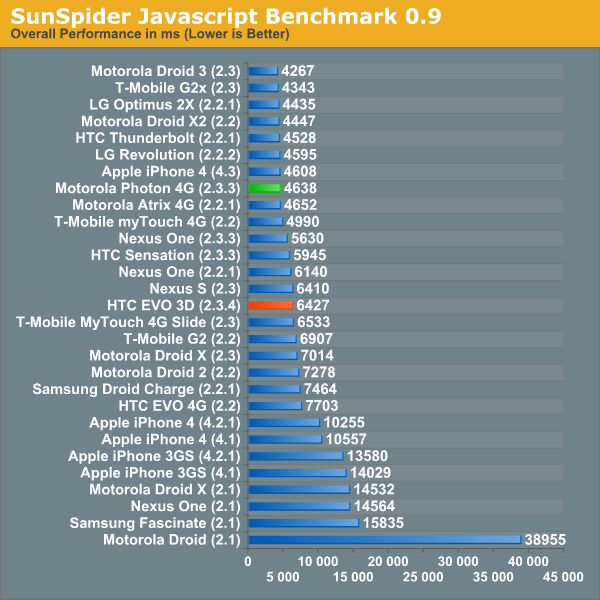
I already alluded to differences in the web browsers of these two phones resulting in varying javascript performance. HTC's browsers have traditionally not performed too well in our javascript tests and unfortunately the EVO 3D is no exception. In our tests it performed a bit worse than its counterpart, the Sensation. In any case, the Photon 4G has two advantages here: the out-of-order A9 architecture as well as a browser with a faster js engine. The comparison here isn't as cut and dry though. Although the EVO 3D's browser has a slower javascript engine, it does scroll smoother than the Photon's browser. The smoother scrolling on the EVO 3D is correctly encapsulated in the relevant scrolling tests in Qualcomm's Vellamo benchmark:
| Qualcomm Vellamo Benchmark - Scrolling Performance Tests | |||||
| Ocean Flinger | Image Flinger | Text Flinger | |||
| HTC EVO 3D | 68.98 | 26.03 | 41.79 | ||
| Motorola Photon 4G | 62.07 | 17.64 | 35.21 | ||
Despite Vellamo being a Qualcomm developed benchmark, the scores in these three tests do echo what I noticed after using the two phones. The EVO 3D's browser has better scrolling performance than the Photon. Neither is perfectly smooth, but the HTC browser is noticeably better than Motorola's.
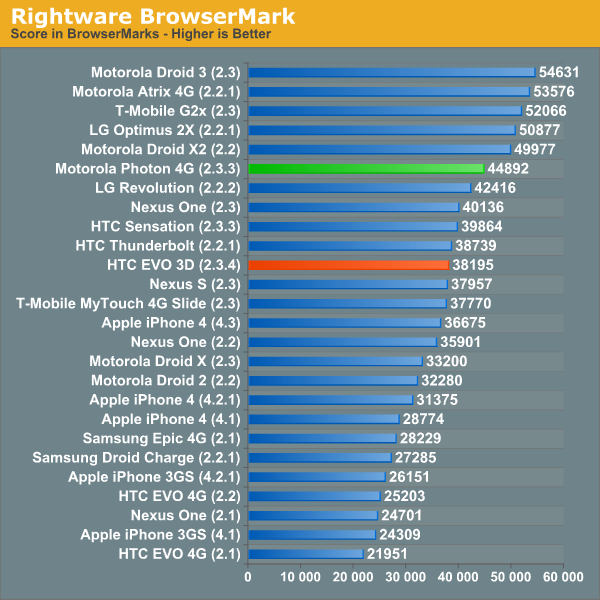
BrowserMark echoes the javascript rendering advantage of the Photon.
Flash performance complicates things. The Photon has consistently better Flash performance regardless of benchmark. GUIMark 2's Vector Charting Test shows the biggest issue with the EVO 3D:
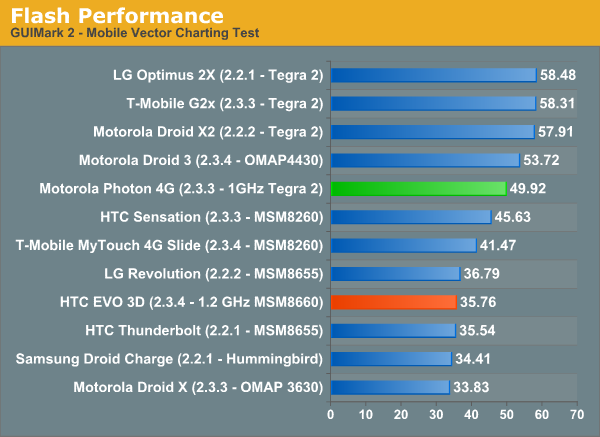
Although the EVO 3D reaches frame rates that are similar to the Photon, lots of stuttering pulls down the average frame rate to what you see above. NVIDIA's Tegra 2 is a clear winner when it comes to Flash performance. Only the OMAP 4 comes close. I'm not entirely sure why the Sensation does so well here, but there's a definite grouping of the Qualcomm based parts.
| GUIMark 3 Performance | ||||||||
| Bitmap - HTML5 Cached | Bitmap - Flash | Vector Test - HTML5 | Vector Test - Flash | Compute - HTML5 | Compute - Flash | |||
| HTC EVO 3D | 51.1 fps | 47.9 fps | 12.4 fps | 27.7 fps | 5.6 fps | 23.3 fps | ||
| Motorola Photon 4G | 37.3 fps | 45.4 fps | 12.1 fps | 35.4 fps | 6.8 fps | 31.3 fps | ||

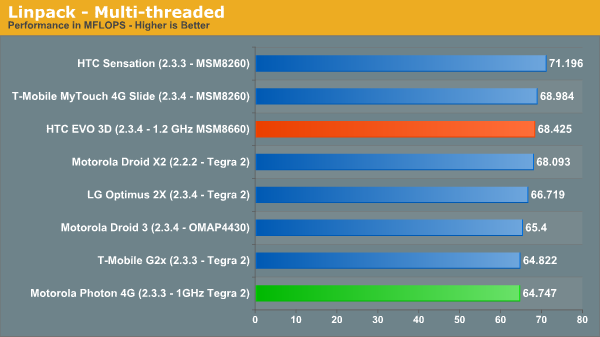
Linpack isn't all that useful of a benchmark under Android, but it does give us an idea of floating point performance of these two platforms. In both cases HTC pulls ahead, likely due to its clock speed advantage.
The GeForce in NVIDIA's Tegra 2 is growing old compared to the latest and greatest from Qualcomm and Imagination. Despite its age however, the Tegra 2 still holds its own pretty well among other qHD competitors. The Adreno 220 and SGX 540 are still faster in our tests though:
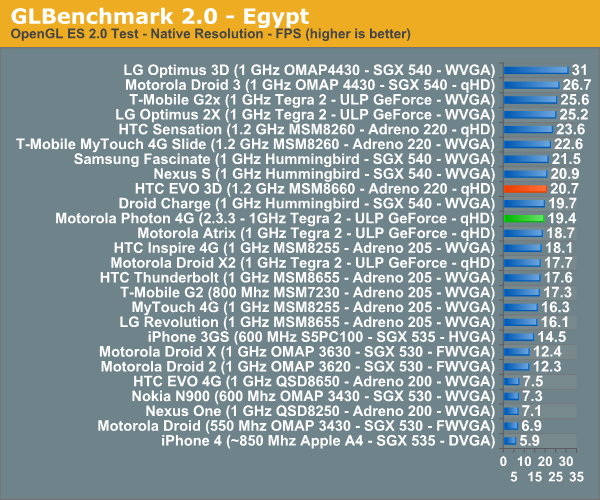

The huge advantage really comes from Basemark ES2 which seems to prefer deferred rendering architectures like the Adreno 220 and SGX 540 to NVIDIA's immediate mode renderer:
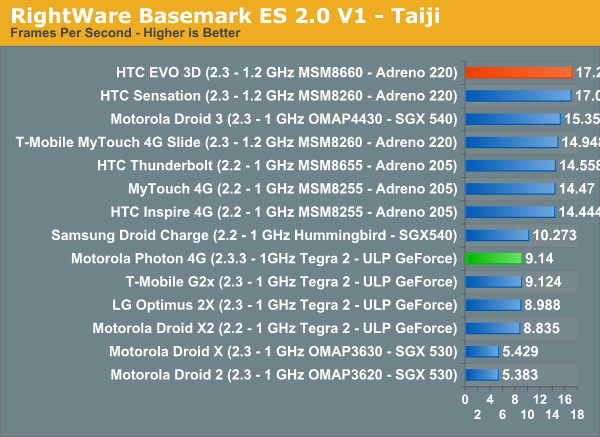
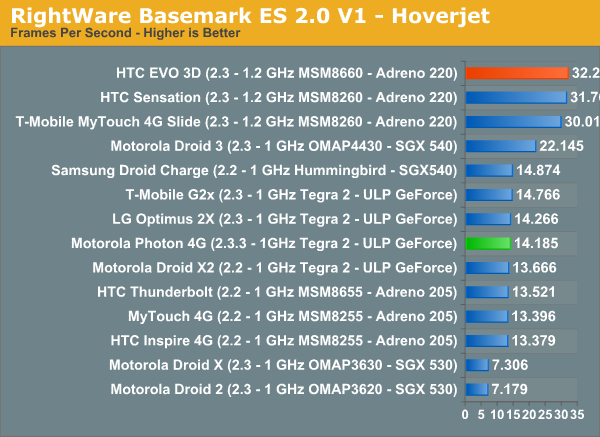
It's difficult to call an overall performance winner here. As we've seen throughout the review, both NVIDIA and Qualcomm trade blows here. The Tegra 2 based Photon 4G has the advantage in Flash and javascript performance while the Snapdragon based HTC delivers smoother browser scrolling and better 3D performance.










43 Comments
View All Comments
RaLX - Wednesday, August 17, 2011 - link
Pentile RGBW blows and it's worse than Pentile AMOLED because at least the latter has great contrast and colors...Are yellows in Photon as bad as in Atrix where they look like brown tinted and uncalibrated?
JayQ330 - Saturday, August 27, 2011 - link
you havent seen the photon's screen its not the same atrix or droid x2 screen you might of seen or read of, how about you read another review from engadget, *everyone knows engadget is biased & only love the iphone, but even they couldnt deny the photons great specs* the plastic feel of the photon? the photon is the most solid, high quality & very detailed android phones released. read other reviews than this one , this is the only review where they said nothing good of the photon. quadrant scores of 2900 to 3100 * those are my scores * most websites report 2900 to 3000 & thats witch a qHD screen! also its only a 1ghz dual core saving much battery & its rgbw pixels save more than 40% battery than average lcd & more than 70% compared to amoled plus. another thing about the screen it seems to be a newer version of samsungs rgbw pentile tech *yes samsung makes that screen* because its not pixelated, no ghosting effect & the colors are better than super lcd while its contrast & blacks are comparable to super amoled..i owned a galaxy s so i know. even ifag sites reviewed the phone & said that the screen is second only to the retina screen which means allot coming from them. you cant see the pixels especially in blacks thats how good the contrast is & its not a washed out black its ink darkness. besides the resolution & not having a virtual keypad that takes up half the screen space because of its higher res screen which is better for any app that you need to text in & any app period. super lcd is already up there with amoled plus do your research before becoming emotionally attached & being worst than ifan boys. besides the tegra 2 is a better more efficient soc than the exynos want proof? look at all the quadrant & antutu scores they're all overclocked to 1.5 ghz! & a droid x2 with half the ram higher resolution and android 2.2 gets higher scores in antutu in graphics & only 200 less points in quadrant. a and heres a better one the galaxy R with its 1 ghz tegra 2 soc gets 3600 in quadrant while the 1.2 ghz exynos gets a 3400 in quadrant! 200 mhz more & still gets less? i guess the lower resolution screen wasnt enough to beat the galaxy R? seriously like a phone for what it can do not what your emotions tell you to do, that a girls job.Alchemy69 - Wednesday, August 17, 2011 - link
With the Samsung Galaxy S II just around the corner why choose either?IKeelU - Thursday, August 18, 2011 - link
[Im]patiently awaiting Galaxy S II review...anindrew - Thursday, August 18, 2011 - link
Exactly! Samsung is supposed to have a big announcement/press release on August 29th. Considering the image they're using for the event has the Roman Numeral II on it and the fact that Samsung's CEO made a statement about the GS2 being released by the end of August, it seems that the GS2 will be released in the very near future.As a Sprint customer who is eligible for a new phone in October, I'm planning to get the GS2 rather than either of the two phones in this review. I'm looking forward to seeing a review of the GS2 on anandtech, especially if it compares the performance on each network. The phones should be nearly identical hardware-wise.
jnads - Thursday, August 25, 2011 - link
Because Samsung software support blows.The Moment never got Froyo, and got EOL'ed after less than a year. The Intercept got EOL'ed and won't get Gingerbread.
The Galaxy S phones _STILL_ don't have Gingerbread 8 months after it was released.
Do you really want a Galaxy S II, knowing you'll never see Android Ice Cream?
g1011999 - Thursday, August 18, 2011 - link
The two cores share a "512MB" L2 cache but have a dual-channel memory interface.Anand Lal Shimpi - Thursday, August 18, 2011 - link
Fixed! Thank you :)Take care,
Anand
Vishnu NS - Thursday, August 18, 2011 - link
In the second paragraph, on the last line, you have written "the two cores share 512 MB of L2 cache...."A good read as always...!!
jjj - Thursday, August 18, 2011 - link
no WIFI perf or even specs ?